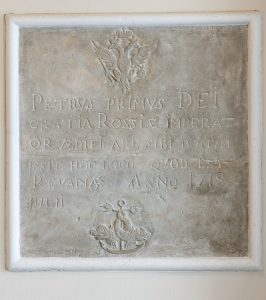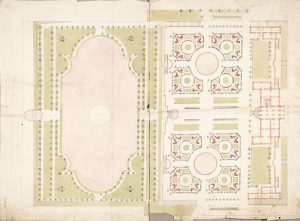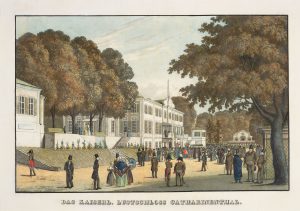The construction of Kadriorg Palace was initiated by Tsar Peter the Great of Russia in 1718. The palace and park ensemble was named Kadriorg (in German Catharinenthal, in Russian Екатериненталь) in honour of his wife Catherine I.
The palace was designed by the Italian architect Nicola Michetti, and its ornate main hall is one of the most exquisite examples of Baroque architecture, both in Estonia and in northern Europe.
Most of the Russian rulers visited their imperial summer residence in Kadriorg. The palace served as the main building of the Art Museum of Estonia in the 1920s, and again in 1946–1991. In the 1930s, it was the residence of the Head of State of the Republic of Estonia. In 2000, the palace re-opened as the Kadriorg Art Museum, which displays the largest collection of old Western European and Russian art in Estonia.
18th century: How the palace came into being
The Great Northern War (1700–1721) had not even finished when Tsar Peter I, certain of his claim over the conquered territories by the Baltic Sea, started to build a new summer palace in the environs of Tallinn which would be worthy of Russian aspirations to become one of the great powers in Europe. Peter, who wished to appear a very European ruler, consciously stressed that he and the whole of Russia belonged to the European cultural space. In his attempts to create a new Russia, Peter began by changing the appearance of the country and its citizens, and architecture played a significant role in this process. In order to construct new residences, building masters and artists were brought to Russia from all over Europe. Among others, Peter asked for the services of the Italian Nicola Michetti (1675–1743), whose first job in Russia was to design the tsar’s summer palace in a nice grove near Reval, as Tallinn was known back then. In the mid-18th century, the area was renamed Kadriorg (or Catharinenthal) in honour of Catherine I. The story of the palace begins in July, 1718, the date carefully recorded by a stonemason’s hand on a memorial plaque in the foyer of the palace.

Construction work in the palace was a joint effort of several foreign masters: in addition to the Italian chief architect, parts of the job were carried out by the Roman architect Gaetano Chiaveri, the Venetian stucco master Antonio Quadri, Salomon Zeltrecht from Sweden, the sculptor Heinrich von Bergen from Riga, and many others. Several of those men later worked in Saint Petersburg; the founding of a new Russian capital also provided employment for another Kadriorg Palace architect, Mikhail Zemtsov, who was in charge of construction in Kadriorg after Michetti returned to Italy. Workers were brought in from Russia, and more difficult tasks were fulfilled by soldiers from the Tallinn garrison or by forced labourers. In the town of Tallinn, which was nearly empty of people and had been severely damaged by war, the construction of an unprecedentedly magnificent palace next to the modest local summer manors, seaside rocks and junipers seemed like a miracle.
The strong will of a ruler who wanted to break from tradition planted a fragile southern architectural masterpiece in the harsh climate of northern Europe. Unfortunately, the builders did not manage to carry out all of Michetti’s and Peter’s grandiose plans because, after the death of the tsar in 1725, the interest of Russian rulers in the Baltic Sea, its navy, Tallinn and the palace died down for quite a while.
Visits of empresses
In the second half of the 18th century, new life was breathed into the palace in connection with the visits of two empresses: Elizabeth of Russia and Catherine the Great. A festive visit to Kadriorg by Elizabeth (or Yelisaveta), the daughter of the founder of the palace, Peter the Great, took place in July, 1746. By that time, the interior and decorations of the palace were finished. Rooms were furnished for the empress in the seaside wing of the building, originally designated for Peter I. The empress spent more than a week revelling lavishly in Tallinn.
After that, the palace stood empty again until the 1764 visit of Catherine II, who had ascended to the throne as a result of a coup d’état in 1762. The palace was once again renovated and furnished, but most of the necessary furnishings were brought from Saint Petersburg or borrowed from Tallinn citizens.
Between the visits of the rulers, the palace was not in use, but it did not stand completely empty. The palace complex was maintained by a castellan, or palace caretaker, who, in the 18th century, was usually an architect by profession and was in charge of maintenance, as well as map drawing and the construction of necessary buildings. From the completion of the initial construction work in the palace until the rule of Nicholas I, four castellan-architects served in the palace: Jacques Broquet (ca 1730–1751), Johann Georg Teichert (1752–1773), Johann Schultz (1773–1795) and Johan David Bantelmann (1795–1826). Their letters and drawings are the main source of the history of the palace, telling us of the life and worries in the palace in the practical language of maps, plans and sums of money.
Throughout the 18th century, the palace kept its original appearance and function as the summer residence of Russian emperors and a beautiful symbol of the presence of authority in this relatively independent province by the Baltic Sea; it was a Baroque frame around the window to Europe created by Peter I.
19th century
A new chapter in the history of Kadriorg began in 1827. As in earlier days, changes were linked to the arrival of a ruler. In that year, Emperor Nicholas I visited Tallinn for the first time, and was very disgruntled that he could not stay in the imperial palace built by Peter I, as Kadriorg Palace was in such bad condition that staying there overnight was impossible. After his visit, the emperor gave orders to transfer the palace, which Paul I had entrusted to the civilian governor of Estonia, back to the administration of the Ministry of the Imperial Court, to immediately start renovation work on the building and park, and to provide the palace and its annexes with everything necessary.
The reconstruction of 1827–1831 was in accordance with the changes that had taken place in the lifestyle of the imperial family and the court. Family relations, feelings and a natural way of life were considered more important than exterior magnificence. So that guests could enjoy the healthy sea air more comfortably, an awning with curtains was placed on the balcony, the stairs leading to the Flower Garden were replaced by a semicircular enclosed veranda, and a new staircase was added to the seaside wing. All of the rooms were fitted with fancy furniture, bathrooms were installed, lamps, Persian rugs and works of art were brought to
Tallinn, and special porcelain sets and glazed earthenware were ordered from the Kiev-Mezhigorsk faience factory.
The purpose of rooms was also altered. The most respectable rooms on the main floor in the seaside wing were furnished as the apartment of Empress Alexandra Feodorovna; above her, on the third floor, the living rooms of the emperor and the crown prince were located; the bedrooms and living rooms of the emperor’s daughters covered both floors of the right wing. The 18th-century ceremonial enfilade of rooms became the summer house of a large family.
In the 19th century, the visits of high society to Tallinn were connected with more than politics. The nobility came here to enjoy the healthy sea water and air, or stopped over on their way to western Europe, which was often the destination of Empress Alexandra Feodorovna, the former Charlotte of Prussia, a daughter of King William III, and her children. An illuminated path leading to the beach, a pier and a bathing house were built for them. To house visitors and numerous courtiers, the old keeper’s house and the pleasure house were rebuilt, a garret was added to the kitchen house, and pavilions with columns were erected in the lower garden.
The imperial family was accompanied to Tallinn and Kadriorg by most of Saint Petersburg’s high society and intelligentsia. Kadriorg became a modern resort for spending summers and improving one’s health. A district of lovely turreted wooden villas was erected around Kadriorg Park, filled with bathing salons, water treatment establishments, hotels, guest houses and restaurants. Towards the end of the century, the area became a bit less glorious as the imperial visits became rarer, particularly after the end of the Crimean War and the building of a railway line to the Crimea, which decreased the Saint Petersburg aristocrats’ interest in the resort in Reval. Kadriorg became a residential area and a summer resort for the wealthy Estonian bourgeoisie.
Gallery
A Temple of Muse
The turbulent and tragic history of the 20th century was also reflected in the life and appearance of Kadriorg Palace. The February Revolution of 1917 overthrew the monarchy in Russia, and the ownerless Kadriorg Palace was soon occupied by the Council of Tallinn Workers and Soldiers. When the palace was given to the city of Tallinn a year later, nothing much remained of the former interior of the imperial residence; even the parquet floor of the main hall was covered with marks left by axes from chopping firewood.

The young Republic of Estonia was faced with the question of what to do with the empty palace; a decision was reached in 1921: the palace was assigned to the Estonian Museum in Tallinn. The first works of art had already moved to Kadriorg before that, as the seaside wing of the palace had been occupied by the first professional Estonian sculptor, August Weizenberg, since 1919. At first, the museum mostly contained items of ethnographic value, as the art collections were still to be put together.

The palace was reopened as a true art museum after thorough renovation in 1927. The expositions included older European art and works by Baltic German artists gathered from state institutions and manor houses, as well as our national pride: artworks by the Estonian artists Johann Köler, August Weizenberg, Paul and Kristjan Raud, and Ants Laikmaa, as well as works by more contemporary artists, such as Konrad Mägi, Peet Aren and Nikolai Triik. Although people were very happy to have their first professional and high-quality art museum, Kadriorg Palace was still considered unsuitable for a museum and there were hopes that a new building would be constructed.

During the first decade of the Republic, Kadriorg became a centre for educated people and artists, many of whom established their studios here, or visited the area to be part of the harmonious coexistence of nature and culture.
Under the Three Lions
Soon after State Elder Konstantin Päts took power, an extensive reconstruction of the palace began. After the designs of the architect Aleksandr Wladovsky, a neo-Baroque banquet hall, a winter garden-orchestra room and a smaller dining hall were added to the palace near the garden-side facade. The private apartment of the Head of State was located on the third floor of the right wing (in current exhibition halls), and his office was on the main floor in the seaside wing, in the room that was initially designated as the bedroom of Peter the Great. The rest of the rooms were meant for housing state visitors or were furnished as parlours in different styles. The interior design stressed magnificence and unity with the European cultural space, the rooms were furnished with stylish antique furniture brought from manor houses or bought in Saint Petersburg. Estonian character was provided by artworks of Baltic-German artists, such as Carl Timoleon von Neff, Eugen Dücker, Oskar Hoffmann and Julius Klever, and the first national artists, Johann Köler and Amandus Adamson. In the late 1930s, some interiors were re-created in the national style, which have been largely preserved to this day. Kadriorg Palace and the surrounding area were turned into a residence of higher state power and were closed off to the public.
Gallery
The rest of Kadriorg Park became a popular place among the townsfolk for taking walks and relaxing. A public area was created in the north-eastern corner of Kadriorg Park, with illuminated alleys, benches, flowerbeds following the patterns of national costume belts, a concert square with a band shell and the Youth Park, with swimming pools, sandboxes and playgrounds.
Main Building of the Art Museum of Estonia
Kadriorg Palace served as the main building of the Art Museum of Estonia again in the years 1946–1991. During the Soviet period, most of the Estonian art life centred on the museum; it housed exhibitions by contemporary artists, displays of classical Estonian art, and exhibitions from abroad, from the works of artists from “friendly” socialist republics to masterpieces of world-famous authors (e.g. Dürer in 1971, Rembrandt in 1978 and Leger in 1974). In the 1950s, the activities in the museum were constrained by ideology; during the thaw of the 1960s, the museum became busier. In the following decades, the old walls of the palace witnessed numerous displays of Estonian avant-garde art and heard heated debates about the issues of contemporary art. Throughout all this, Kadriorg Palace was a beloved, but still only provisional home for Estonian art, the magnificent Baroque architecture of the building being more of a hindrance than an asset to its owner. In 1991, the completely run-down building was closed for thorough renovation and restoration.
Gallery
Open to the World
In its new role as the Kadriorg Art Museum, the palace holds works worthy of its architecture and is open to the general public. The halls of the palace contain older Western European and Russian art – paintings, sculptures and applied art – which add magnificence and glory to the building that had lost its former fancy interiors. We could say that in addition to the art collection of the state of Estonia, which is exhibited in Kadriorg, the most important object on display is the palace itself.
Gallery
The past of the palace has become a legend told to all visitors, with the accompanying presentation of the layers from different eras inside the building as well as outside: the main hall and facade from the period of Peter the Great, stairs and room allocation from the 19th century, the neo-Baroque banquet hall and rooms with oak furnishings in the national style from the period of the first Republic of Estonia. The story of Kadriorg can be heard in almost twenty different languages in the palace and it keeps spreading throughout the world. In addition to the old stories, new ones are born in the palace: thousands of children begin their discovery of the world of art here, as they reinterpret the palace and its legacy, intertwining the stories from old times with their own tales.
Kadriorg Palace today preserves and values its history but is not overly attached to it; rather, it aspires to be open to everyone and everything that allows new ways to interpret and find inspiration in art.
Gallery



























